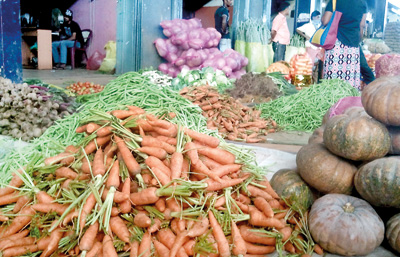News
Vegetable prices go sky high after torrential rains destroy crops
View(s):By Sonja Candappa, Pix by Kanchana Kumara Ariyadasa
Heavy rains and subsequent floods experienced in the recent past resulted in the destruction of many crops and land, leading to increased prices of almost all agricultural produce.
Vegetables were the most affected due to crops being destroyed. As a result the prices of vegetables sky rocketed and vendors say that until new crops are harvested there will be no reduction in prices, with stocks priced differently in various parts of the island.

Scenes at the Dambulla Economic Centre on Friday: No takers for veggies piled high.
At the Dambulla Economic Centre the wholesale price of a kilo of beans was Rs. 200, carrot priced at Rs. 160 a kilo, capsicum at Rs. 250 a kilo, brinjals at Rs. 250 a kilo, red onions at Rs. 140 a kilo, beet at Rs. 130 a kilo and tomatoes at Rs. 65 a kilo, on Friday.
Dambulla Economic Centre Chairman U.B Ekanayaka warned on Friday, that the price of brinjals may increase to as much as Rs. 500 a kilo in the next week, and requested the Government to import vegetables from neighbouring countries like India to prevent the prices from increasing any further.
Prices of other vegetables have also risen at the Dambulla Economic Centre. Mr. Ekanayaka said on Friday that the consignment of vegetables, such as dambala, string beans, cucumber, kekiri, brinjals, and batu arriving from low country areas like Anuradhapura, Polonnaruwa and Matale, were the most affected.
At the Meegoda Dedicated Economic Centre, the wholesale price of brinjals was Rs. 235 a kilo, pumpkins Rs. 55 a kilo, beans Rs. 280 a kilo, carrots Rs. 195 a kilo, beet Rs. 195, a kilo, capsicum Rs. 310 a kilo and green chillies at Rs. 220 a kilo.
A media report this week reported that the Meegoda Economic Centre development officer Samantha Sooriyagoda had said that prices of certain vegetables had increased by 100 percent in the recent past, and that there was a 90 percent drop in the stocks received at the Centre.
At the Colombo Fort Manning Market, the wholesale price of leeks is now Rs. 120 a kilo, capsicum is Rs. 280 a kilo, beans Rs. 220 a kilo and carrots Rs. 180 a kilo. Consequently the retail prices are Rs. 300 a kilo for capsicum, Rs. 230 a kilo for beans and Rs. 200 a kilo for carrot.
Dayaratna of Panagoda who sells vegetables at the Manning Market, said that prices of some vegetables have increased by nearly Rs. 100 a kilo over the past five or six days. He said that his business is not really affected because even though people buy reduced quantities now there is no loss as very little stocks come to the market anyway. “This is all due to the rains destroying the crops. We are not that affected because our wares are anyway sold. It’s the consumer who suffers the most. People who used to buy kilos of vegetables, now buy only about 250 to 500 grams of a variety,” he said.
Thilakaratna Bandara, a consumer from Ragama who buys vegetables from the Manning Market said that the prices of vegetables have gone ‘sky high’.
“I don’t remember vegetables being this costly even during the time of the war,” he said, adding that there are no vegetables to buy even at higher rates. At the Swayam Rakiya Market in Colombo Fort, the vendors have begun to cheat,” Bandara said.
I paid for 250 grams of beans, but when I weighed it at the Manning Market the scale recorded only 200 grams, he said.
Munidasa, 44, an onion vendor from Kelaniya said all the local red onion crops were destroyed.
“The harvest from Puttalam was rotten and the crop from Jaffna had begun to sprout roots. Now we can only sell the onions imported from Thailand, resulting in a Rs. 30 increase in the price of a kilo of red onions,” he said.
Sunil, 55, a vendor from Kiribathgoda who sells cabbages at the Manning Market said the wholesale price of cabbage had increased by more than Rs. 15 a kilo because 50 percent of the crops were destroyed by the rains and subsequent flooding.
Munavweera, a tomato vendor from Kotte said that the price of tomatoes has actually dropped. Now the wholesale price of tomatoes stands at Rs. 60 a kilo – a Rs. 20 drop – since the second week of January.
Vegetable prices go sky high after torrential rains destroy crops
By N. Parameswaran
Jaffna has turned to be one of the most costly towns with house rents, food and vegetables prices rising. Residents said that before 1983 Jaffna was a suitable town to live in economically or a place to live with a lower income; compared to other towns like Colombo or Kandy.
The average room rent in the town or in the Nallur area now ranges between Rs. 3,000 and Rs. 7,000. An ordinary two bed-roomed house (without attached bathroom) is between Rs. 7,000 and Rs. 12,000 in the town area. The minimum three-wheeler charge for a trip is Rs. 100 whereas in Colombo it is Rs. 50 in a metered taxi.
A call taxi service has also been established in Jaffna but its charges are also Rs. 20 higher than the Colombo rate with the minimum charge being Rs. 300. In the past two weeks vegetable prices in Jaffna have also skyrocketted.
Among the items which are highly priced are (per kilogram) drumstick Rs. 1,000, brinjal Rs. 320, long beans Rs.300, beans Rs. 200, ladies fingers Rs. 120, bitter gourd Rs. 200, leeks Rs.140, pumpkin Rs. 70, tomatoes Rs. 100, ash plantains Rs. 100, cabbage Rs.100, beetroot Rs. 120.00, casava manioc Rs. 40, onions Rs.120.00 and green chillies Rs.180.00.
(Additional reporting by Kanchana Kumara Ariyadasa)
Follow @timesonlinelk
comments powered by Disqus















